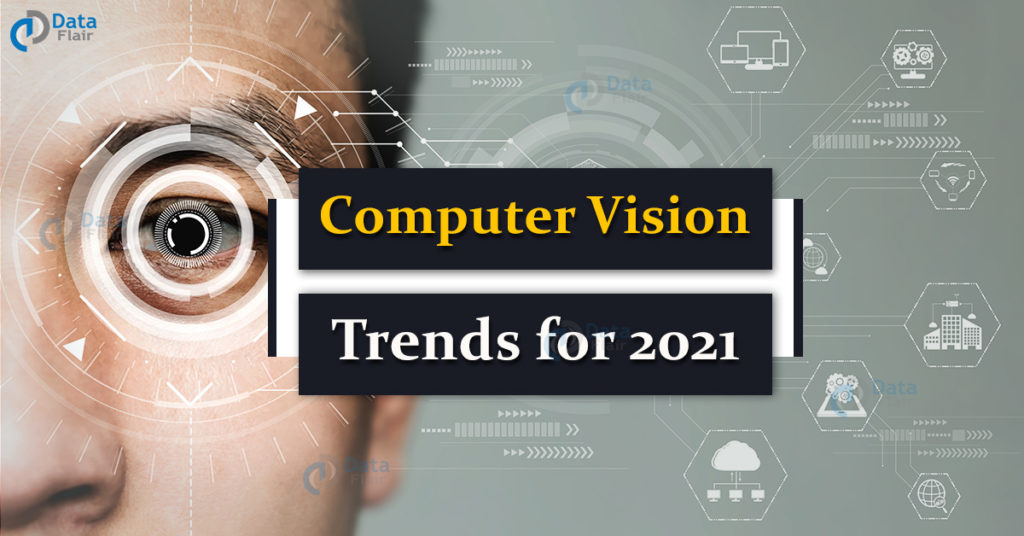Computer vision and machine learning have really started to take off, but for most people, the whole idea of what is a computer seeing when it’s looking at an image is relatively obscure.
Mike Krieger
The spread of the global pandemic has forced multiple industries to quickly adapt to newer technologies.
With industries looking to cut labour costs and the economic slowdown that is expected to follow the pandemic, the adoption of new technologies will continue to remain a top choice in 2021.
One technology that has stood out during COVID times is a branch of AI called computer vision.
Often abbreviated as CV, computer vision is a field where computers are made capable of analyzing the content in digital images and videos.
Computer Vision is an emerging field with a lot of potential.
Here are some of the top Computer Vision trends that are set to dominate 2021.
Keeping you updated with latest technology trends
Follow DataFlair on Google News
Popular Computer Vision trends for 2021
1. Computer vision for automated defect identification
Companies in the manufacturing industry spend hours on manual detection of manufacturing defects.
In some cases, the defects remain undetected due to human error. In others, it is impossible for the human eye to detect minute defects.
Visual inspection tools that are built based on computer vision technology are capable of enhancing the production quality.
Implementing the solution is affordable. It provides great accuracy too.
Thus, with an automated visual inspection, manufacturing units can achieve better quality control and save time/costs at the same time.
2. Emergence of Edge Computing
Currently, most of the company’s huge datasets are there in the cloud.
However, one must also consider the offices that are located in remote places where weak or no internet connection makes it hard to connect to the cloud.
Edge computing refers to technology that enables data processing and analysis at the site of data collection.
Thus, there is no need to connect to the cloud.
In locations where network outages are common, edge computing provides a way to carry out data analysis without interruptions.
Are you looking forward to work on real-time computer vision projects?
Top 25 Computer Vision Projects [source code included]
3. Ensuring safety in the times of COVID
Industries are grappling with getting employees back to the office.
With social distancing norms and other restrictions in place, employees now have a bigger responsibility when it comes to ensuring the safety of their employees.
There is a need to ensure that people wear their masks and follow the rules of the new normal when they are in a public place.
Computer vision can be used to detect whether people are following all the norms.
Cameras can be set up to enable live monitoring of public places, especially during peak hours.
Apart from safety measures against the virus, CV can also help monitor whether the employees are well-protected when they enter risky areas such as construction sites.
4. CVaaS will become more prominent
At the moment, we have software, platform and infrastructure available as a service.
2021 will see even computer vision available as a service.
This will fuel the zeal and passion to innovate more as there is no need to spend time on building a dedicated computer vision platform.
Companies will be able to lease CV software and pay only for those applications that they use.
5. Thermal Imaging
Thermal cameras use light/heat energy to analyze the surroundings.
These have been applied in various fields for a long time. They have been helpful for military personnel to have night vision. They have been used in wildlife study and exploration.
The combination of thermal imaging and deep learning algorithms is a powerful one.
Manually checking each person’s temperature during the pandemic is an inefficient method.
Taiwan adopted thermal cameras in combination with facial recognition tools to make the process more efficient.
AI-based temperature monitoring solutions can help increase the operation speed in airports and other public spaces in the post-pandemic world.
Summary
Computer vision would take the centrestage in many industries; especially those involving manufacturing products.
Edge technology combined with CV as a Service would make it feasible to seamlessly embed CV into several devices.
In the post-pandemic world, CV may even become the norm when it comes to matters such as automated inspection, AR and VR.
It is expected that AR and VR will move to the next phase of development to give birth to MR – mixed reality.
